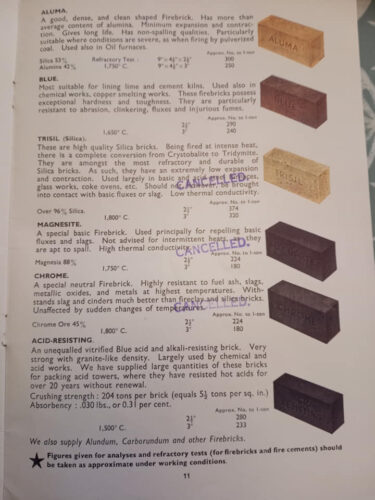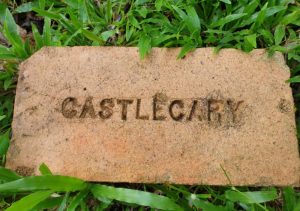I am now fairly certain this is another example of a Scottish company, Castlecary Fireclay Co, Cumbernauld, manufacturing bricks for a customer, J. H. Sankey & Son, Ilford, Essex and adding their name to the brickmark.
I am not sure, but I think originally J.H. Sankey may have been merchants only thus they had bricks in their name manufactured elsewhere for them to sell on. From the 1951 reference below they may have then moved into manufacturing their own refractory products.
See John Bramall’s thoughts in the comments section at the bottom of the page.
I will leave my original musings below in case our assumption is not correct.
***********************************
Information and clarity sought. – Castlecary Fireclay Co, Cumbernauld, Scotland … VERSUS … J H Sankey & Son, Essex Wharf, Canning Town, London E and Ilford, Essex, England.
Castlecary Fireclay Co, Cumbernauld was established during the late 19th century by Alexander Weir and incorporated in 1909. The works in Castlecary were known as Weir’s Castlecary in order to distinguish from Stein’s Castlecary Works which were nearby. I am not aware of Stein ever marking any of his bricks with Castlecary.
Below – 1899 – J.H Sankey & Son, Essex Wharf, Canning Town, London – 1857 Company established. – Note the reference to Castle Cary Sankey London (Castle Cary, Somerset as opposed to Castlecary, Cumbernauld?) and “Castle Cary” is in quotes which may infer it is a different Company to Sankey?
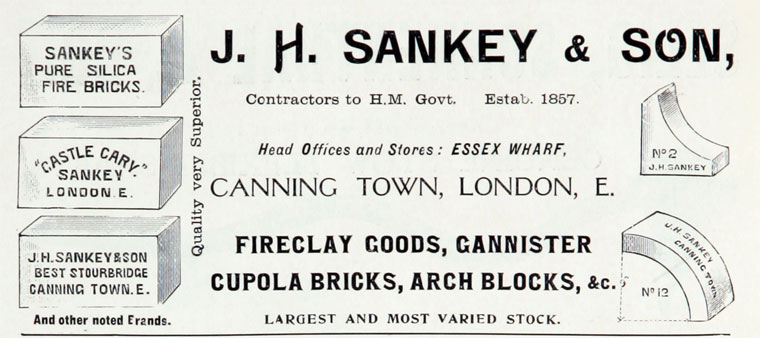
Now then there are a few “facts” that I cannot get straight viz
Below – Numerous ‘Sankey’ bricks are found in Scotland and are attributed to JH Sankey as in

and
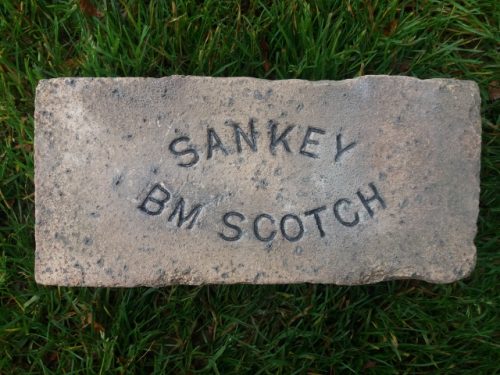
The Canningtown mark above appears to confirm that the mark BM Scotch belongs to JH Sankey.
But what does BM stand for – perhaps British Made?
and why the mark ‘Scotch’. Scotch is normally used alongside a product that is made in Scotland eg ‘Scotch broth’ or ‘Scotch whisky’ or ‘Scotch plaid’. So could BM Scotch mean this is a British product made in Scotland?
You will note from the advert above that JH Sankey also made a brick marked Castle Cary (note the 2-word spelling), Sankey London E. The village of Castle Cary is in Somerset and I cannot find a reference for a brickworks there. There is, of course, the village of Castlecary near Cumbernauld with a huge brickmaking history. So, then I find these bricks below at the Weir Castlecary brickworks … Which are marked Castlecary, Sankey, London?
1951 – Sankey (J. H.) & Son Ltd. Head Office: Aldwych House, Aldwych, London WC2. Works: Refractories Works, Ilford, Essex. T.A “Sankey, Ilford”. T.N., Ilford 1127 (6 lines). Established in 1857. Fire cements: Pyruma, Aluma and Siluma; tile cement: Tiluma; firebricks; B.M.Scotch, Aluma (highly aluminous), Leolite (super aluminous), refractory-insulating, etc.; Super acid-resisting cement; acid-resisting bricks: vitrified blue acid and alkali-resisting bricks.
Trade Name: Sankey “Top Brand”.
Directors: M. Sankey; W. G. Lance; J. C. Field.

and

Below – There is no space in the word Castlecary so this is more likely to be the Scottish village but why add Sankey, London if it is a product of Scotland.

Below – Then there is this ‘Sankey’ brick which I found numerous of at the Craigend Brickwork’s, Falkirk. You will note from this link that this Sankey Aluma brick is very similar in shape, size, inclusions, colour and mark to others found at Craigend and confirmed as being their product.

Below – And this further anomaly below does not help clarify the situation at all – Glascot, BCM/Sankey, although rather than Glascot being short for Glasgow Scotland it may refer to the Glascote Brickworks, Near Tamworth.
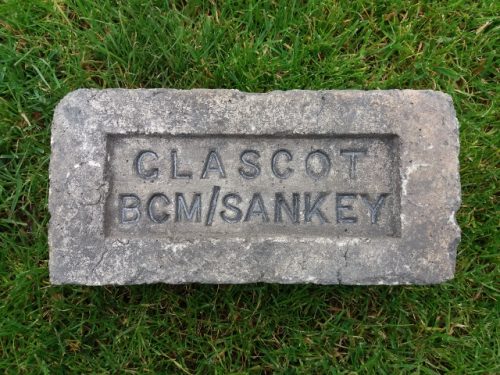
Is there a connection between Castlecary and Sankey via this info below? – if there is I can not see it!
1890 – Castlecary Fire Clay Co., Ltd., 2 Exchange place, Middlesbrough; Joseph McLauchlan, agent.

Link to Sankey bricks
Link to Castlecary Fireclay Co bricks
So my question is – can all ‘Sankey’ marked bricks be attributed solely to JH Sankey London or is it possible that some ‘Sankey’ bricks were made in Scotland and in particular at Castlecary. How do we explain the Castlecary, Sankey and London bricks? Did Castlecary, Scotland make bricks in Scotland for Sankey and thus marked them up Castlecary Sankey – many Scottish makers eg Hurll, Stein marked their client’s names on bricks they made for them.
All insight or thoughts welcome.
*******************************************
EUREKA! – I believe the following 1922 advert for Sankey’s fire bricks is the evidence I am looking for to support the theory that the Castlecary Fireclay Company were making bricks for Sankey and marking the bricks accordingly. (Note – SBH – I have left my musings above in case my assumption here is incorrect)
Below – 28/12/1922 – The Foundry Trade Journal – States Sankeys Canningtown – We have large stocks of our Scotch, Stourbridge, North Country, Staffordshire and Silica Fire bricks …
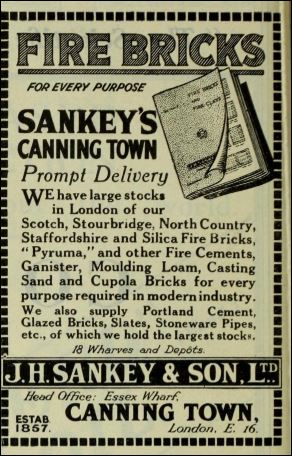
Below – The following corroborative information comes from a catalogue in the possession of Chris Graham. It is dated c. 1930.
J. H Sankey and Son Ltd – BM Scotch. Among the finest Scotch bricks available. Manufactured from selected Scotch clay seams. Being fired at a very high temperature, after contraction is negligible. Resists intense and intermitted temperatures and most fluxes. Medium thermal conductivity. Used extensively in iron and steelworks., power stations, glassworks, chemical works and by railway and steam companies. Ideal for all industries where there is excessive heat, continuous and intermittent. Especially recommended to our Scottish customers. Silica 58%, alumina 37% – 17oo deg C. 2 1/2″ width = 320 per ton. 3″ width = 264 per ton.

.

Below – Aluma – A good dense and clean shaped fire brick. Has more than the average content of alumina. Minimum expansion and contraction. Gives long life. Has non-spalling qualities. Particularly suitable where conditions are severe as when firing by pulverised coal. Used in oil furnaces. Silica 53%. Alumina 42%. Refractory test 1,750c. 2 1/2″ width bricks = 300 per ton. 3″ width bricks = 250 per ton. (Note – SBH – There is no reference to such Sankey Aluma bricks being manufactured in Scotland but it is entirely possible that some were manufactured at the Craigend Refractories, Scotland as many have been found there).
